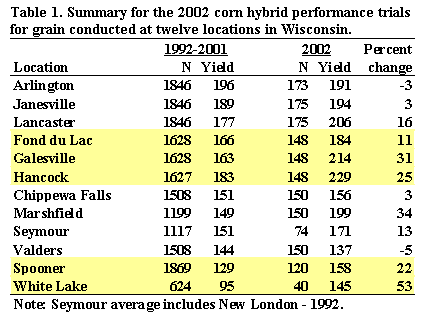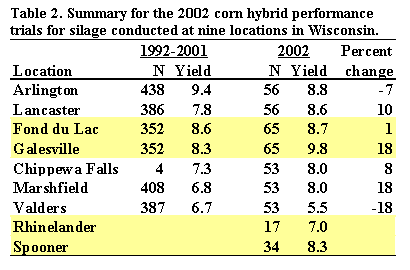Looking Back on Corn Production in 2002
January 15, 2003 10(1):3-5
Joe Lauer, Corn Agronomist
The corn production year of 2002 had high corn yields in western Wisconsin. Spring
planting condiions were warm and dry during April, followed by cool and wet weather
during early May resulting in an overall slow start for corn. Growth caught up by
early July with hot, dry weather. For the second year in a row, drought conditions
existed during the pollination and grain-filling periods in the northeast. Timely
rains in western Wisconsin resulted in favorable pollination conditions. Corn silage
harvest started slightly later than normal. A killing frost did not occur until
mid-October. Excellent plant standability was observed in most trials.
Corn grain yields in the UW Corn Hybrid Performance trials were above average in
most locations around the state (Table 1). During 2002 all locations, except
for Arlington and Valders had 3 to 53 percent yield increases over the ten-year
period from 1992 to 2001. The Arlington site had problems at emergence, while the
Valders site had drought occur around pollination and into early grain filling.
The hishest yields for the state were observed in the south central production zone
(Fond du lac, Galesville and Hancock). A total of six hybrids from the south central
production zone had record-breaking performance for Wisconsin since 1972, while
three hybrids had record yields in the northern zone.

Corn silage yields in the UW Corn Hybrid Performance trials reflected what occurred
in the grain trials (Table 2). Three new sites were added in 2002 at Rhinelander
and Spooner (Irrigated and Silt Loam sites). Silage yields were 1 to 18 percent
above the ten-year period from 1992 to 2001. Galesville recorded the highest silage
yields, which were 18 percent above the ten-year average. Lower than average yields
were observed at Arlington and Valders. At the new sites, Rhinelander and Spooner,
average yields of 7.0 to 8.3 tons of dry matter were measured.

A recent trend we have been following in the UW Corn Performance trials is the frequency
of normal dent corn hybrids yielding above the trial average (Figure 1). Until 1998,
normal dent corn hybrids as a group were distributed around the trial average in
a 50:50 ration, i.e. 50% of the normal dent corn hybrids were above the trial average
and 50% of the hybrids were below the trial average. Beginning in 1999 and continuing
through 2002 the frequency with which normal dent corn hybrids yield above the trial
average has been decreasing. In 2002 only 39% of the normal dent corn hybrids yielded
above the trial average. There are still quite a few normal dent corn hybrids that
have excellent performance and are the top hybrids in a trial, but as a group the
frequency they perform in the top group was less in 2002.

There are at least two possible reasons that might explain this observation. First,
the Bt trait is being incorporated into the best genetics available. Normal dent
corn hybrids are being replaced by hybrids with the Bt trait with about 61 to 83%
of the hybrids finish above the trial average. Second, low undetected European Corn
Borer pressure exists in the trials and is reducing the performance of normal dent
corn hybrids. The latter reason, although a possibility, is unlikely since the trials
are scouted every 2 to 3 weeks and little ECB damage is observed. Refugia of 20%
of the corn acreage on a farm is required by EPA and must be maintained in order
for Bt transgenics to continue to be a farm field tool for controlling ECB. In Wisconsin,
20% of the acreage represents 680,000 acres that must be planted to normal dent
corn (USDA, 2001 Statistics). It is imperative that adapted high-performing normal
dent corn hybrids remain available to corn farmers.
Looking ahead to 2003, the biggest concern right now is for soil moisture. A lot
of precipitation can occur between now and the cropping season, but coming out of
a dry fall and the lack of precipitation so far this winter is disconcerting. In
2003 some farmers will be getting some early observations on the performance of
corn rootworm resistant hybrids. This is an exciting technology and tool that farmers
will have the opportunity to integrate into their farming systems. The recent startup
of Wisconsin ethanol plants should result in lower basis and greater demand for
corn grain with a shift in grain movement around the state. The new USDA organic
standards will have some implications for corn production in Wisconsin. Ag professionals
will need to continue monitoring possible development of pest resistance in transgenic
corn.